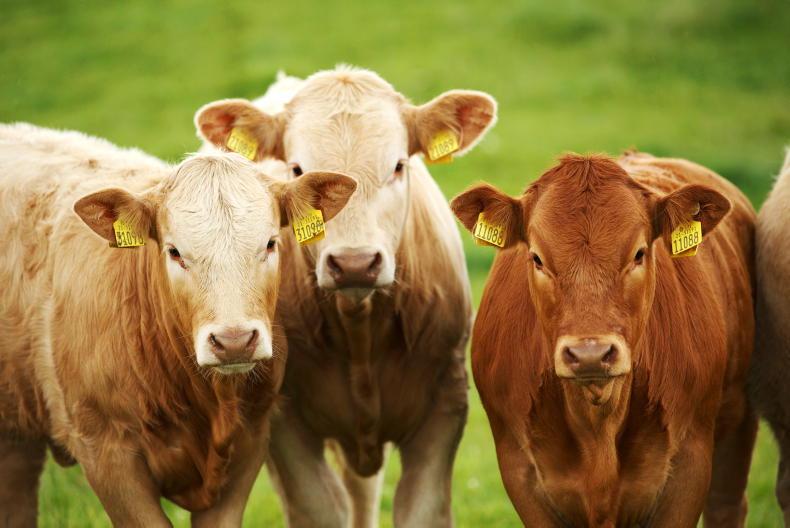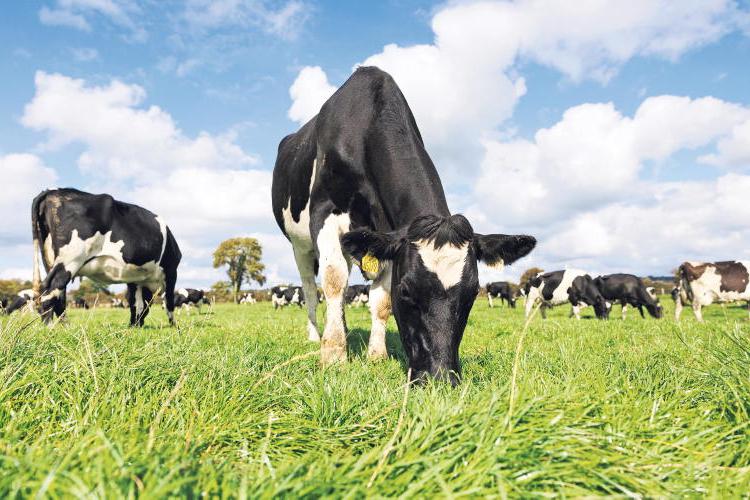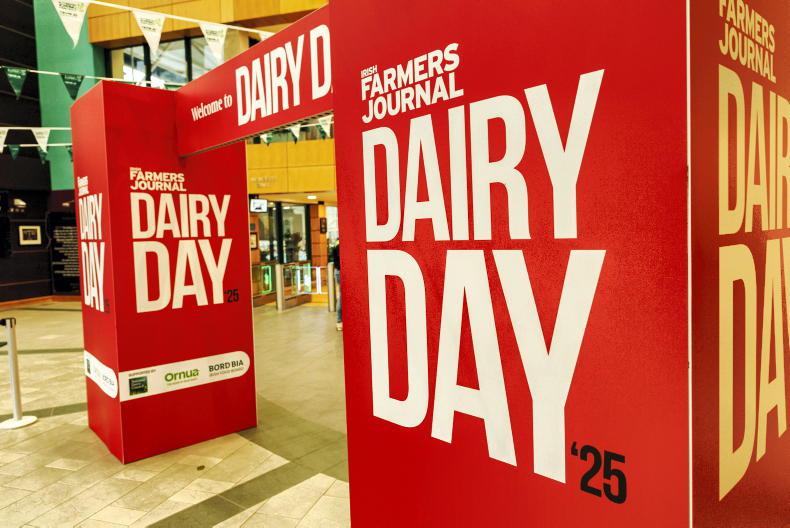Despite what Bord Bia called a “challenging operating environment” last year, Ireland’s food exports exceeded €16bn for a second year in 2023. It certainly is a positive sign that much of the huge gain in the value of exports seen in 2022 was retained last year. However, those sales were made against a backdrop of much higher industry input costs and an increasingly tight labour market.
But more about that later. Let’s first look at what Ireland sold, and where in the world it went.
One of the most striking things from Bord Bia’s Export Performance and Prospects Report is the jump in the proportion of food exports that went to our closest market, the UK.
The country accounted for 34% of the total, up two percentage points from 2022, and at the highest level since 2018. It is notable that these numbers are far below the 40% share that existed prior to the Brexit referendum.
While the share to the EU remained relatively stable at 38%, the mix of products was different with a significant drop in the value of dairy exports to France, Germany and the Netherlands balanced by increased dairy trade with Poland and higher value of prepared consumer foods (PCF) exports to the region.
Away from local markets, there was a second year of declining export share to the rest of the world. In 2023, that share dropped to 30%, with the value of exports tumbling 10% from 2022 levels.
Irish dairy exports dropped by almost 8% in 2023 to €6.3bn. The largest value drop by product was in butter which saw a decrease of an estimated €175m to €1.3bn.
The key German market was particularly challenging as high grocery inflation there saw some consumers trade down to lower-value products.
Nutritional powders
Skim milk powder, fat-filled milk powder and casein also saw falling values. There were a couple of bright spots in the market, with cheese exports growing 4% to match butter’s €1.3bn as European prices remained strong.
Specialised nutritional powders also had a good year, growing 6% to €800m.
On the outlook for dairy, the report says a “modest increase” in supply from main exporting regions is likely this year.
Irish supplies
While Irish supplies are estimated to have dropped around 2% in 2023, Bord Bia says favourable weather or improved milk prices could help boost milk volumes in 2024.
They do add a caveat to that forecast, saying the uncertainty around the impact of nitrates changes on stocking rates and the high cost of land rental may prove a headwind to any output expansion.
There is optimism about consumer behaviour as much of the production costs increases have already been passed through to shoppers, meaning fewer price rises in 2024 could lead to a return in demand for dairy products this year.
The value of beef primary exports rose 2% to €2.7bn last year, with value-added beef in the PCF sector increased 7% to €255m and beef offal up 3% to €140m.
The UK market dominated Irish beef exports, accounting for 47%, or €1.3bn, in 2023.
The scarcity of cattle in the UK, and demand for in-spec beef among large retail and foodservice customers maintained the demand for Irish beef during the year.
Domestic supplies
The EU made up for another 48% of Irish beef exports, with domestic supplies in the region remaining tight. Demand for higher-value cuts such as steaks was lower as the cost-of-living crisis impacted consumer behaviour.
Bord Bia’s Meat Shopper Insight Tracker found that 72% of shoppers in the main export markets said they considered purchasing beef, but they often didn’t end up buying the product as it was considered “too expensive” against other meal options.

The UK market dominated Irish beef exports, accounting for 47%, or €1.3bn, in 2023. \ Donal O'Leary
Beef exports to the rest of the world are estimated to have dropped by almost a quarter to €128m, representing less than 5% of total value for the sector.
Australian beef
Bord Bia says cheaper Australian beef particularly impacted the competitive position of Irish beef in Asia, and the closure of the Chinese market in November further curtailed supplies to the region.
Irish beef exports to China had amounted to €25m between the lifting of the suspension in April and the reintroduction in November.
Bord Bia’s outlook for the sector suggests that developments will be very much driven by consumer demand.
Globally, beef supplies are expected to decrease marginally, mostly driven by the reduction in the US herd.
Overall, the market is expected to remain well balanced on the supply side in both the EU and globally as demand from Asia remains weak.
As with dairy, a relaxation of the cost-of-living crisis in 2024 could help demand for high-quality Irish beef in key UK and EU markets.
Irish sheepmeat exports declined 7% to €440m in 2023, the first fall in value after seven years of growth. The drop was driven by shifts in consumer demand as well as increased production in the southern hemisphere.
The notable increase in the availability of UK sheepmeat in key export markets also put pressure on Irish exports.
Those key export markets continued to be the EU, taking €325m last year, and the UK, which took €70m.
Of the €50m of exports to international markets, two-thirds went to Switzerland, meaning the rest of the world accounted for a tiny proportion of the total.
The outlook for the sheepmeat sector, similar to dairy and beef, is challenged by the reduction in consumer demand due to higher prices.
There is also the risk that high Australian and New Zealand production, coupled with weaker returns in the key Chinese market, could see more of that product make its way to the UK and EU, further eroding Irish sheepmeat competitiveness in those key markets.
It is no secret that 2023 was another difficult one for the pigmeat sector, with Bord Bia estimating that exports totalled €475m, a 13% drop on 2022’s level and the smallest export value since at least 2018.
Across the EU pig producers continue to exit the industry as, despite record prices hit in 2023, the backdrop of legacy debt from the cost of production crisis means many in the industry remain very cautious.
Sales to international markets dropped from 64% of exports in 2022 to 52% in 2023
Higher animal welfare and environmental standards are also leading to increased costs.
Exports to the UK were the only bright spot for Irish producers, with sales increased by an estimated 41% to €133m. Exports to the EU dropped 7% to €94m.
Sales to international markets dropped from 64% of exports in 2022 to 52% in 2023.
Bord Bia expects Irish production to gradually recover from the start of this year, reflecting some recovering in the pig breeding herd on the back of more favourable prices and some downward readjustment in production costs.
Live animal exports, with an estimated value of €265m (a 13% increase) in 2023, were dominated by exports to Northern Ireland, which accounted for 59% of the trade.
The Netherlands was the strongest market for dairy male calves with 110,000 head traded, accounting for more than half of all Irish calf exports.
With the trading of animals remaining under intense scrutiny at both local and European level, the longer-term future of this trade is in doubt.
For older cattle, the market looks positive in key EU markets as tight domestic supplies there are set to continue to drive demand. The supply outlook for Northern Ireland also looks subdued, Bord Bia said, which is expected to drive stable demand this year.
The fall in the value of Irish food exports last year can be seen as news that is less bad than it might have been. However, it has to be taken in the context of the rapid rise in production costs, both at the farm and processor level in the last couple of years.
As part of its report Bord Bia conducted a short pulse check with leadership of major exporters to help understand current sentiment in the sector.
While 73% of respondents see some expansion in exports this year, more than half see their company’s competitiveness eroding due to higher energy prices, input costs and labour costs.
Of those three, labour costs were cited by the largest number as a “very high risk” to their competitiveness, with a further 33% saying it is relatively high risk.
Labour costs are unlike most other input costs that companies face. Energy prices fluctuate rapidly, and supply chain disruptions can be overcome. But labour costs, while they tend to rise more slowly, almost never go down.
In what remains a highly competitive market for workers – Ireland’s unemployment rate stands at 4.4% – companies face the dual challenge of both the cost and availability of labour.
But the same companies also generally need consumers with disposable incomes to buy their higher-value products.
The only way to square this circle seems to be an increased reliance on automation, which would mean less labour needed per unit of production.
Despite what Bord Bia called a “challenging operating environment” last year, Ireland’s food exports exceeded €16bn for a second year in 2023. It certainly is a positive sign that much of the huge gain in the value of exports seen in 2022 was retained last year. However, those sales were made against a backdrop of much higher industry input costs and an increasingly tight labour market.
But more about that later. Let’s first look at what Ireland sold, and where in the world it went.
One of the most striking things from Bord Bia’s Export Performance and Prospects Report is the jump in the proportion of food exports that went to our closest market, the UK.
The country accounted for 34% of the total, up two percentage points from 2022, and at the highest level since 2018. It is notable that these numbers are far below the 40% share that existed prior to the Brexit referendum.
While the share to the EU remained relatively stable at 38%, the mix of products was different with a significant drop in the value of dairy exports to France, Germany and the Netherlands balanced by increased dairy trade with Poland and higher value of prepared consumer foods (PCF) exports to the region.
Away from local markets, there was a second year of declining export share to the rest of the world. In 2023, that share dropped to 30%, with the value of exports tumbling 10% from 2022 levels.
Irish dairy exports dropped by almost 8% in 2023 to €6.3bn. The largest value drop by product was in butter which saw a decrease of an estimated €175m to €1.3bn.
The key German market was particularly challenging as high grocery inflation there saw some consumers trade down to lower-value products.
Nutritional powders
Skim milk powder, fat-filled milk powder and casein also saw falling values. There were a couple of bright spots in the market, with cheese exports growing 4% to match butter’s €1.3bn as European prices remained strong.
Specialised nutritional powders also had a good year, growing 6% to €800m.
On the outlook for dairy, the report says a “modest increase” in supply from main exporting regions is likely this year.
Irish supplies
While Irish supplies are estimated to have dropped around 2% in 2023, Bord Bia says favourable weather or improved milk prices could help boost milk volumes in 2024.
They do add a caveat to that forecast, saying the uncertainty around the impact of nitrates changes on stocking rates and the high cost of land rental may prove a headwind to any output expansion.
There is optimism about consumer behaviour as much of the production costs increases have already been passed through to shoppers, meaning fewer price rises in 2024 could lead to a return in demand for dairy products this year.
The value of beef primary exports rose 2% to €2.7bn last year, with value-added beef in the PCF sector increased 7% to €255m and beef offal up 3% to €140m.
The UK market dominated Irish beef exports, accounting for 47%, or €1.3bn, in 2023.
The scarcity of cattle in the UK, and demand for in-spec beef among large retail and foodservice customers maintained the demand for Irish beef during the year.
Domestic supplies
The EU made up for another 48% of Irish beef exports, with domestic supplies in the region remaining tight. Demand for higher-value cuts such as steaks was lower as the cost-of-living crisis impacted consumer behaviour.
Bord Bia’s Meat Shopper Insight Tracker found that 72% of shoppers in the main export markets said they considered purchasing beef, but they often didn’t end up buying the product as it was considered “too expensive” against other meal options.

The UK market dominated Irish beef exports, accounting for 47%, or €1.3bn, in 2023. \ Donal O'Leary
Beef exports to the rest of the world are estimated to have dropped by almost a quarter to €128m, representing less than 5% of total value for the sector.
Australian beef
Bord Bia says cheaper Australian beef particularly impacted the competitive position of Irish beef in Asia, and the closure of the Chinese market in November further curtailed supplies to the region.
Irish beef exports to China had amounted to €25m between the lifting of the suspension in April and the reintroduction in November.
Bord Bia’s outlook for the sector suggests that developments will be very much driven by consumer demand.
Globally, beef supplies are expected to decrease marginally, mostly driven by the reduction in the US herd.
Overall, the market is expected to remain well balanced on the supply side in both the EU and globally as demand from Asia remains weak.
As with dairy, a relaxation of the cost-of-living crisis in 2024 could help demand for high-quality Irish beef in key UK and EU markets.
Irish sheepmeat exports declined 7% to €440m in 2023, the first fall in value after seven years of growth. The drop was driven by shifts in consumer demand as well as increased production in the southern hemisphere.
The notable increase in the availability of UK sheepmeat in key export markets also put pressure on Irish exports.
Those key export markets continued to be the EU, taking €325m last year, and the UK, which took €70m.
Of the €50m of exports to international markets, two-thirds went to Switzerland, meaning the rest of the world accounted for a tiny proportion of the total.
The outlook for the sheepmeat sector, similar to dairy and beef, is challenged by the reduction in consumer demand due to higher prices.
There is also the risk that high Australian and New Zealand production, coupled with weaker returns in the key Chinese market, could see more of that product make its way to the UK and EU, further eroding Irish sheepmeat competitiveness in those key markets.
It is no secret that 2023 was another difficult one for the pigmeat sector, with Bord Bia estimating that exports totalled €475m, a 13% drop on 2022’s level and the smallest export value since at least 2018.
Across the EU pig producers continue to exit the industry as, despite record prices hit in 2023, the backdrop of legacy debt from the cost of production crisis means many in the industry remain very cautious.
Sales to international markets dropped from 64% of exports in 2022 to 52% in 2023
Higher animal welfare and environmental standards are also leading to increased costs.
Exports to the UK were the only bright spot for Irish producers, with sales increased by an estimated 41% to €133m. Exports to the EU dropped 7% to €94m.
Sales to international markets dropped from 64% of exports in 2022 to 52% in 2023.
Bord Bia expects Irish production to gradually recover from the start of this year, reflecting some recovering in the pig breeding herd on the back of more favourable prices and some downward readjustment in production costs.
Live animal exports, with an estimated value of €265m (a 13% increase) in 2023, were dominated by exports to Northern Ireland, which accounted for 59% of the trade.
The Netherlands was the strongest market for dairy male calves with 110,000 head traded, accounting for more than half of all Irish calf exports.
With the trading of animals remaining under intense scrutiny at both local and European level, the longer-term future of this trade is in doubt.
For older cattle, the market looks positive in key EU markets as tight domestic supplies there are set to continue to drive demand. The supply outlook for Northern Ireland also looks subdued, Bord Bia said, which is expected to drive stable demand this year.
The fall in the value of Irish food exports last year can be seen as news that is less bad than it might have been. However, it has to be taken in the context of the rapid rise in production costs, both at the farm and processor level in the last couple of years.
As part of its report Bord Bia conducted a short pulse check with leadership of major exporters to help understand current sentiment in the sector.
While 73% of respondents see some expansion in exports this year, more than half see their company’s competitiveness eroding due to higher energy prices, input costs and labour costs.
Of those three, labour costs were cited by the largest number as a “very high risk” to their competitiveness, with a further 33% saying it is relatively high risk.
Labour costs are unlike most other input costs that companies face. Energy prices fluctuate rapidly, and supply chain disruptions can be overcome. But labour costs, while they tend to rise more slowly, almost never go down.
In what remains a highly competitive market for workers – Ireland’s unemployment rate stands at 4.4% – companies face the dual challenge of both the cost and availability of labour.
But the same companies also generally need consumers with disposable incomes to buy their higher-value products.
The only way to square this circle seems to be an increased reliance on automation, which would mean less labour needed per unit of production.










SHARING OPTIONS